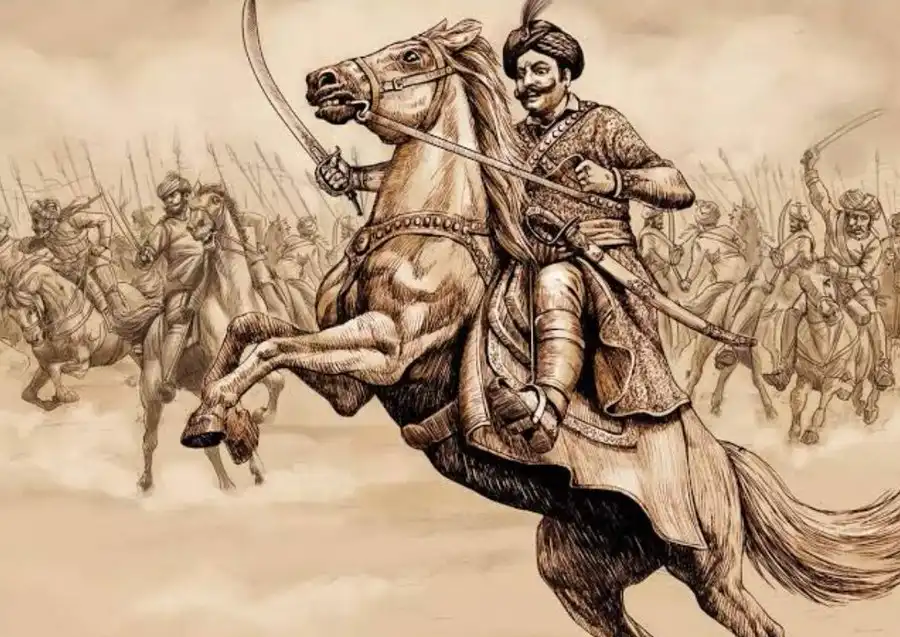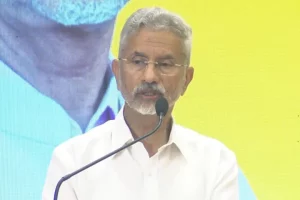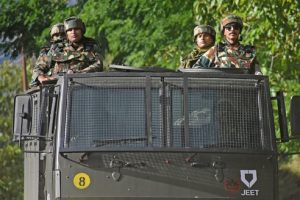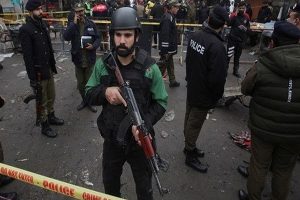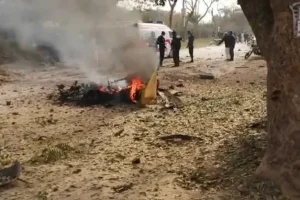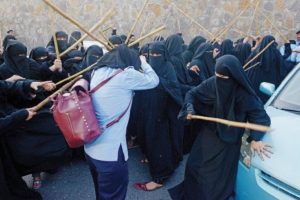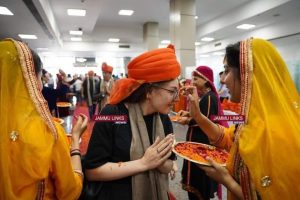After India’s NSA Ajit Doval and the then ISI Chief Faiz Hameed met in the UAE, several stories broke out that India and Pakistan are breaking the ice and a peace scenario was possible. Soon after the Doval-Faiz meeting, Pakistan showed its commitment by resuming the 2003 ceasefire agreement signed between the parties. As compared to 4,645 ceasefire violations in 2020, there were only 3 incidents since the understanding of 2021 and only 1 in 2022.
In March 2021, the then Chief of the Army Staff (COAS) Qamar Javed Bajwa made a startling remark at the Islamabad Security Conference that it is time for India and Pakistan to bury the past and move forward. But in August 2021, during a speech at the Pakistan Military Academy, Kakul, he raised the issue of Kashmir again and lamented how India is occupying it and how Pakistan continues to support the Kashmiri people.
On January 2023, Pakistani journalist Javed Chaudhary who is said to be close to Bajwa wrote an article claiming India and Pakistan were close to signing a peace deal in April 2021. Prime Minister Narendra Modi was supposed to visit Pakistan for nine days where he would have visited the Hinglaj Mata temple in Balochistan as he is a devotee after which Modi and then PM Imran Khan would have signed a peace deal most dramatically by raising arms and declaring friendship between the two countries. The peace deal supposedly had three important components –trade, no terrorism and burying the Kashmir issue for 20 years. Bajwa stated it was Khan who sabotaged the peace deal as he thought any compromise on Kashmir would end his political career.
A few days after journalist Chaudhary’s story got out, sensational news broke where Prime Minister Shahbaz Sharif while giving an interview to an Al Arabiya journalist in UAE stated that “it is up to us to live peacefully and make progress or quarrel with each other and waste time and resources. We have three wars with India and it only brought more misery, poverty and unemployment to the people. We have learnt our lesson and we want to live in peace provided we are able to resolve our genuine problems. We want to alleviate poverty, achieve prosperity, and provide education and health facilities and employment to our people and not waste our resources on bombs and ammunition that is the message I want to give to PM Modi”.
While Sharif made this peace overture, on the same day a clarification was made by the Pakistani PMO through its official Twitter handle that peace talks with India are only possible if India reverses its actions of 5 August 2019, when the special status of Kashmir was taken away.
In ref. to PM Shehbaz Sharif's interview to Al Arabiya, the spokesman of the PM Office has said the PM has consistently maintained that Pakistan & India must resolve their bilateral issues, especially the core issue of Jammu & Kashmir, through dialogue and peaceful means. 1/3
— Prime Minister's Office (@PakPMO) January 17, 2023
While the political leadership in Pakistan may utter one statement, their institutions are likely to contradict it and even within the Pakistan Democratic Movement (PDM) different political parties are likely to make different comments, making it difficult to take Pakistan at its word.
The Pakistani Army is not much different from its political leadership.
On 6 August 2019, then COAS Bajwa stated that Pakistan never recognised the sham Indian efforts to legalise its occupation of Jammu & Kashmir through Article 370 or Article 35-A decades ago. But in a closed-door meeting with the UK’s High Commissioner to Islamabad, Christian Turner, Bajwa stated that for peace with India, restoration of Article 35A of India’s Constitution was a must. Article 35A prohibited outsiders from purchasing land in the erstwhile state of J&K.
CCC on Kashmir situation at GHQ. Forum fully supported Government’s rejection of Indian actions regarding Kashmir. Pakistan never recognised the sham Indian efforts to legalise its occupation of Jammu & Kashmir through article 370 or 35-A decades ago; …(1of2). pic.twitter.com/MlwNJTSDGa
— DG ISPR (@OfficialDGISPR) August 6, 2019
Pakistan continues to maintain terror infrastructure on its side of the Line of Control (LoC) and other parts of the country. Terrorist attacks continue unabated in J&K. Since the renewal of the ceasefire agreement, the total number of killings of civilians and security forces numbered 36 and 45 respectively in 2021. While for 2022 it was 30 each for civilians and security forces. Before the ceasefire agreement, in 2020 numbers stood at 33 and 56 for civilians and security forces.
Pakistan has revised its modus operandi as ceasefire violations remain negligible but attacks on Hindus have increased through the newly formed terror organization The Resistance Front (TRF) which is an off-shoot of Lashkar-e-Toiba (LeT) and was created by Pakistan after the abrogation of Article 370.
With increasing global pressure, Pakistan is exporting terrorism through various means. One of the killers of the Udaipur-based tailor Kanhaiya Lal, Ghouse Mohammad has links with the Karachi-based Barelvi organization Daawat-e-Islami (DeI) and had visited Karachi in 2014. DeI is no strange to killings as Mumtaz Qadri, the killer of Punjab Governor Salman Taseer, belongs to this organization.
In January 2023, a chillingly similar piece of news was reported in which Harkat-ul-Ansar, a Pakistan-based terrorist group influenced Naushad to kill influential Hindus. To show his loyalty, Naushad beheaded a Hindu man in Delhi with the help of Jagjit Singh, a Khalistan supporter, who was in contact with terrorist Arshdeep Dalla of the Khalistan Tiger Force.
These examples show that despite invocations of peace with India, Pakistan continues to carry on with its avowed plan to bleed India with a thousand cuts.
It continues to interfere in India’s internal affairs by causing disturbances at various levels. In Punjab alone in year 2022, there were a total of 266 drone incidents used to supply narcotics, guns and grenades. In Dec 2022, a Pakistani boat with 40 kg of drugs and weapons was seized by the Indian Coast Guard along with 10 crew members.
The Pakistani economy is in doldrums and it is struggling to raise a bailout package of $1 billion from the International Monetary Fund (IMF). Adding fuel to this fire are serious attacks on Pakistani security forces by the Tehreek-e-Taliban (TTP). These days Indians will hear big words on peace and brotherly relations from various quarters in Pakistan but what remains important is Pakistan’s track record.
Let’s look at some of the major events of the last 20 years.
In 1999 when Atal Bihari Vajpayee went to Pakistan to formulate peace between the two countries, then Pakistan COAS Gen. Pervez Musharraf initiated the Kargil war. Soon after in 2001, the Indian Parliament was attacked by Pakistan-backed LeT and the Jaish-e-Mohammad (JeM). One of the prime reasons why the Agra Summit collapsed was that the joint declaration draft didn’t contain references to cross-border terrorism.
In 2006, terrorists from Pakistan killed 200 Indians in multiple train blasts. In 2008, 26/11 happened in which 166 people were butchered by 10 LeT terrorists. In Dec 2015, PM Modi went to Pakistan to greet then Prime Minister Nawaz Sharif at his granddaughter’s wedding and a few days later in January 2016, the Indian base in Pathankot was attacked by Pakistani terrorists.
In September 2016, four terrorists from JeM attacked the Uri military camp killing 19 soldiers; a few days later India retaliated across the LoC by way of a surgical strike.
In February 2019, Jaish-e-Mohammad terrorists rammed an explosive-laden car with a bus carrying a CRPF convoy thereby killing 40 soldiers, India responded by carrying out an air strike crossing the international border and bombing Balakot, Khyber Pakhtunkhwa.
On 16 February 2023, security forces foiled an infiltration bid and neutralized one terrorist in the Tangdhar sector of Baramulla, Kashmir. On 8-9 March, a Bangladesh national infiltrating through Amritsar sector was arrested.
An intruder from Pak side was trying to enter India on the intervening night of 8-9th March, near BOP Rajatal, Amritsar sector . He was fired upon by the BSF troops on duty and subsequently arrested. During initial questioning he revealed his identity as a Bangladeshi national. pic.twitter.com/sX9nADBexv
— Ravinder Singh Robin ਰਵਿੰਦਰ ਸਿੰਘ رویندرسنگھ روبن (@rsrobin1) March 9, 2023
Further, on 10 March, BSF caught infiltrators crossing from Punjab’s Ferozepur border
India has stated clearly that the onus is on Pakistan and neighbourly relations could only be developed when no terror or violence comes from Pakistan which seems difficult as Pakistan is resistant to change.
Even as I write this article, statements from important personalities of Pakistan show their real intentions. Retired Army personal Maj Gen Athar Abass, ex-DG ISPR, speaking at the Karachi Literature Festival 2023 suggested that Pakistan should focus on its economy and once Pakistan reaches parity than it can deal with India.
In a similar vein, Vice President of Asia Group, Uzair Younus, whose India trip amazed everyone on both sides of the border suggested that Pakistan should grow its economy and once it attains progress it can deal with India.
It is time India wakes up regarding Pakistan and gets out of its Prithviraj Syndrome. The Prithviraj Syndrome, as the name suggests is about Samrat Prithviraj Chauhan and his debacle. In 1191, Mohammad Ghori fought with Prithviraj Chauhan and lost in the first Battle of Tarain. Chauhan could have easily killed Ghori but he didn’t after which the second Battle of Tarain took place in 1192 in which Ghori didn’t show mercy and executed Prithviraj.
India has repeatedly followed the legacy of Prithviraj Chauhan and has been regularly deceived as was done by Ghori to Chauhan.
I would like to end this article with a warning to India to understand the intentions of Pakistan by playing with a couplet from Prithviraj Raso:
Is Baar Toh Mat Chuke Hindustan
Nahi Toh Phir Se Chaunkega Hindustan






